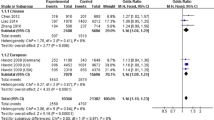Abstract
In the present study, we investigated whether polymorphism of ARNTL2 (BMAL2) gene rs2306074 T/C was associated with susceptibility of Alzheimer disease (AD) in Chinese population. A case–control method was employed in this study. 296 unrelated AD patients and 423 control subjects were recruited in current study. The prevalence of C carriers in BMAL2 gene rs2306074 T/C in AD patients was significantly higher than that of control subjects in both the whole sample and APOE ε 4 non-carriers (in the whole sample: χ 2 = 5.938, P = 0.012; in APOE ε 4 non-carriers: χ 2 = 9.048, P < 0.0001). In addition, both in the whole sample and APOE ε 4 non-carriers, prevalence of CC genotypes in BMAL2 gene rs2306074 of AD patients was also significantly higher than that in controls (in the whole sample: χ 2 = 5.126, P = 0.018; in APOE ε 4 non-carriers: χ 2 = 7.389, P = 0.023). However, there was no significant difference of prevalence of C carriers and CC genotypes in BMAL2 gene rs2306074 T/C between AD patients and control subjects among APOE ε 4 carriers (C carriers: χ 2 = 0.020, P = 0.900; CC genotypes: χ 2 = 0.017, P = 0.946). C carriers in BMAL2 gene rs2306074 T/C are associated with a high susceptibility of AD among APOE ε 4 non-carriers but not among APOE ε 4 carriers in Chinese population.
Similar content being viewed by others
References
Barnes DE, Yaffe K (2011) The projected effect of risk factor reduction on Alzheimer’s disease prevalence. Lancet Neurol 10:819–828
Bettens K, Sleegers K, van Broeckhoven C (2010) Current status on alzheimer disease molecular genetics: from past, to present, to future. Hum Mol Genet 19(1):R4–R11
Cermakian N, Lamont EW, Boudreau P, Boivin DB (2011) Circadian clock gene expression in brain regions of Alzheimer’s disease patients and control subjects. J Biol Rhythms 26:160–170
Chartier-Harlin MC, Parfitt M, Legrain S, Pérez-Tur J (1994) Apolipoprotein E, epsilon 4 allele as a major risk factor for sporadic early and late-onset forms of Alzheimer’s disease: analysis of the 19q13.2 chromosomal region. Hum Mol Genet 3:569–574
Chaudhary R, Likidlilid A, Peerapatdit T, Tresukosol D, Srisuma S (2002) Apolipoprotein E gene polymorphism: effects on plasma lipids and risk of type 2 diabetes and coronary artery disease. Cardiovasc Diabetol 11:36. doi:10.1186/1475-2840-11-36
Chen JM, Huang CQ, Ai M, Kuang L (2013) Circadian rhythm of TSH levels in subjects with Alzheimer’s disease (AD). Aging Clin Exp Res 25:153–157
Chen HF, Chang-Quan H, You C, Wang ZR, Hui W (2013) The circadian rhythm of arterial blood pressure in Alzheimer disease (AD) patients without hypertension. Blood Press 22:101–105
Chen Q, Huang CQ, Hu XY, Li SB, Zhang XM (2012) Functional CLOCK gene rs1554483 G/C polymorphism is associated with susceptibility to Alzheimer’s disease in the Chinese population. J Intern Med Res 41:340–346
Chen HF, Huang CQ, You C, Wang ZR, Si-qing H (2013) Polymorphism of CLOCK gene rs 4580704 C>G is associated with susceptibility of Alzheimer’s disease in a Chinese population. Arch Med Res 44:203–207
Cochrane A, Robertson IH, Coogan AN (2012) Association between circadian rhythms, sleep and cognitive impairment in healthy older adults: an actigraphic study. J Neural Transm 119:1233–1239
De Giorgi A, Mallozzi Menegatti A, Fabbian F, Portaluppi F (2013) Circadian rhythms and medical diseases: does it matter when drugs are taken? Eur J Intern Med S0953–S6205(13):00103–00109
Eichner JE, Dunn ST, Perveen G, Thompson DM, Stewart KE (2002) Apolipoprotein E polymorphism and cardiovascular disease: a HuGE review. Am J Epidemiol 155:487–495
Gritton HJ, Sutton BC, Martinez V, Sarter M, Lee TM (2009) Interactions between cognition and circadian rhythms: attentional demands modify circadian entrainment. Behav Neurosci 123:937–948
Hemmeryckx B, Himmelreich U, Hoylaerts MF, Lijnen HR (2011) Impact of clock gene Bmal1 deficiency on nutritionally induced obesity in mice. Obesity (Silver Spring) 19:659–661
Liu RY, Zhou JN, Hoogendijk WJ, van Heerikhuize J, Kamphorst W, Unmehopa UA, Hofman MA, Swaab DF (2000) Decreased vasopressin gene expression in the biological clock of Alzheimer disease patients with and without depression. J Neuropathol Exp Neuro 59(4):314–322
Milagro FI, Gómez-Abellán P, Campión J, Martínez JA, Ordovás JM (2012) CLOCK, PER2 and BMAL1 DNA methylation: association with obesity and metabolic syndrome characteristics and monounsaturated fat intake. Chronobiol Int 29:1180–1194
Pappa KI, Gazouli M, Anastasiou E, Iliodromiti Z, Antsaklis A, Anagnou NP (2013) The major circadian pacemaker ARNT-like protein-1 (BMAL1) is associated with susceptibility to gestational diabetes mellitus. Diabetes Res Clin Pract 99:151–157
Retz W, Thome J, Durany N et al (2001) Potential genetic markers of sporadic Alzheimer’s dementia. Psychiatr Genet 11:115–122
Scott EM, Carter AM, Grant PJ (2008) Association between polymorphisms in the clock gene, obesity and the metabolic syndrome in man. Int J Obes 32:658–662
Whitmer RA, Gunderson EP, Quesenberry CP, Zhou J, Yaffe K (2007) Body mass index in midlife and risk of Alzheimer disease andvascular dementia. Curr Alzheimer Res 4:103–109
Yang Y-K, Peng X-D, Li Y-H, Wang Z-R, Chang-quan H (2013) The Polymorphism of CLOCK Gene 3111T/C C9T is associated with susceptibility of Alzheimer disease in Chinese population. J Investig Med 61:1084–1087
Acknowledgments
This work was supported by the Science and Technology Graveness Project of Sichuan Province (2010FZ0061) and from the Illustrious Youth Specialist Project of Sichuan Province (2012JQ005). The authors thank the staff of the Key Laboratory of Chronobiology of Health Ministry in Basic and Forensic School of Sichuan University, and the Department of Geriatrics of the third hospital of Mianyang, and all study participants (as well as their legal proxies) for their great contributions.
Conflict of interest
The authors wish to extend their full confidence that there are no conflicts of interest in this research article and that only the fullest integrity was practiced in its composition.
Author information
Authors and Affiliations
Corresponding author
Rights and permissions
About this article
Cite this article
Qing-Xiu, L., Chang-Quan, H., Qian, C. et al. The polymorphism of ARNTL2 (BMAL2) gene rs2306074 C>T is associated with susceptibility of Alzheimer disease in Chinese population. Neurol Sci 35, 1743–1747 (2014). https://doi.org/10.1007/s10072-014-1824-3
Received:
Accepted:
Published:
Issue Date:
DOI: https://doi.org/10.1007/s10072-014-1824-3



